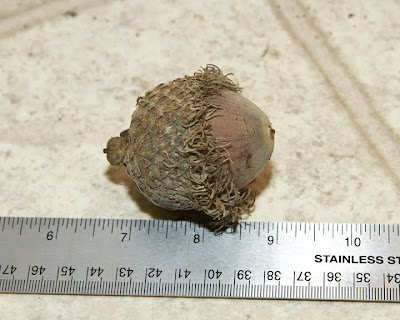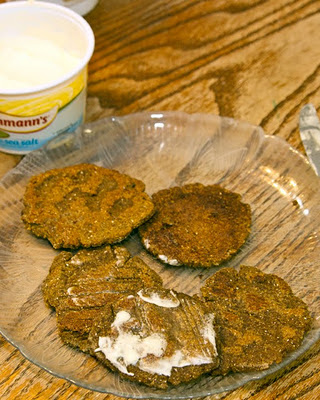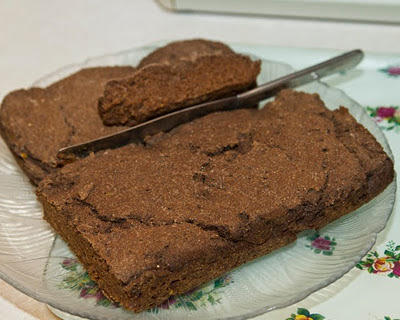Folks who know me know that my interests tend to be somewhat eclectic. And can blossom up quite unexpectedly. As I'm picking up a few of these monster acorns with the vague idea of planting them somewhere, I remember that acorns were a major food source for Native Americans and early settlers. The German settlers in Texas relied heavily on acorns in the early years to ward off starvation. So the idea of cooking with a portion of this huge acorn crop took root. The birds nest-like cup holds onto the nut tightly, even after dropping from the tree, so I placed my collected acorns, one by one, on a cast iron skillet and whacked them with a hammer. I didn't hit too hard so as not to crush the nut. Two moderate whacks was usually enough to crack the cup and underlying shell enough to pry everything apart with a flat head screwdriver, as seen below.
As you can see, the nut meat of a burr acorn is quite attractive once shelled. It is a nice, creamy color with a texture not unlike a chestnut. In fact, peeling the acorn shell and underlying skin from the nut meat is very, very similar to doing the same with a chestnut (only a bit easier, since the skin doesn't willingly come off a chestnut unless it is cooked some). I also shelled an acorn from a live oak in the neighborhood, just for comparison. Look at the size difference--someone would have to shell half a dozen live oak acorns or more to equal a single burr acorn! And from experience, I can say that live oak acorns do not shell any more quickly, despite their smaller size. Also, note the yellower color of the live oak acorn. This is significant.
I shelled about half the acorns I'd collected, and filled a bowl with the nut meats. Looks pretty good, doesn't it? Yeah, but the taste ain't all that. Any kid who'd seen a squirrel chomping on an acorn and tried it himself knows that acorns are bitter. That's the tannins in them, the same thing that gives red wine its mouthfeel and what originally was used to tan leather. High amounts of tannins can be toxic to humans. What to do? Well, not all acorns are created equal. In North America, there are two general classifications of the various oak tree species: Red oaks and White oaks. Red oak types (which include actual red oaks) tend to have pointed tips on their leaves and produce acorns that take two years to mature and drop. That's a lot of time for tannins to develop. White oak types (which include actual white oaks) tend to have rounded tips on their leaves and produce acorns that mature and drop in a single growing season. Hence, white oak types have less tannin content, and it is my understanding that some species even have acorns that are sweet and edible right off the tree. The burr is a white oak type, with low tannin levels. That yellow in the live oak acorn? That means it's got a lot more tannins, and is a lot more bitter. Yay for serendipity! Also, I have to point out (since I've not seen it elsewhere) that shelled acorns will oxidize fairly quickly. Within an hour of shelling, the pieces of nut meat were browning along the edges and exposed surfaces. It's not particularly pretty, but it seems harmless enough.
Even so, the burr acorns were still too bitter to use without a bit of processing. The tannins need to be leached out of the nuts. I crushed the nuts into chunks, then used an inexpensive electric coffee grinder to chop them up into a very coarse meal. Native Americans, at this point, would scoop out a hole in clean sand near a water source and place the meal in there and pour water over it until the tannins had been leached away. Contemporary folk often put the meal in a nylon mesh bag and soak in boiling water repeatedly until the tannins leach out. Since water can only hold so much tannin before saturated, repeated soakings are necessary. I read in several places online that if the acorns are transferred from boiling water to room temperature and then heated to a boil, the remaining tannins are actually locked in. Therefore, it's necessary to have two pots of water heating constantly. As this struck me as labor intensive, I opted for a less labor-intensive cold water leaching method--I bagged the meal and submerged it in the reservoir tank of the downstairs toilet. I know, it doesn't sound appealing. But the reservoir is clean, and to make doubly sure, I bleached it out thoroughly. I left the meal in for several days, and the continual flow of water from flushing and filling did the job nicely. I was actually able to track the progress of the leaching by watching the clarity of the water improve as the tannin levels declined. Before long I had unbitter acorn meal. I spread the meal out on a cookie sheet and placed in the oven, setting it to bake at around 120 degrees with the door open for drying. Every 10 minutes or so I'd stir the meal. After an hour or so the meal was dry enough for my purposes.
Note that acorns are fairly high in fat, so the nut meats and meal need to be stored in cool conditions, or frozen for long-term storage, otherwise they could go rancid. Yuck! Fortunately, I wasn't waiting that long. All of the meal and oxidized during the leaching process, so the resulting meal was a uniform brown. I took the coarse meal, chunks and all (visible in the lower right of the photo above) and ground it to a fine meal using the electric coffee grinder. The resulting acorn meal (center bowl, above) has a nice color and a texture a bit finer than regular corn meal. It is more clumpy, though. I decided to try a very simple recipe first, and came across the following from this site.
Apache acorn cakesThe dough is very coarse, even though I used whole grain corn flour instead of corn meal. I figured out right away that "tortilla-like" was a non-starter. They simply wouldn't hold together when pressed that thin. I finally settled for a thicker, cookie-like form, and this worked fine. They cooked quite easily. The honey made them nicely sweet, but not cloying. The texture was similar to a heavy cornbread, and the acorns gave a nutty taste. The Wife wasn't terribly impressed, and the Bug wouldn't touch any, but Monkey Girl and Fairy Girl though the "acorn cookies" delicious and devoured most of them topped with melted butter.
1 cup acorn meal, ground fine
1 cup cornmeal
1/4 cup honey
pinch of salt
Mix the ingredients with enough warm water to make a moist, not
sticky dough. Divide into 12 balls. Let rest, covered, for 10 minutes or so. With slightly moist hands, pat the balls down into thick tortilla-shaped breads. Bake on an ungreased cast iron griddle
Buoyed by my modest success with the acorn cakes, I decided to try my hand at actual acorn bread. Since acorn flour is "heavy" and lacks gluten, it won't rise on its own and needs to be combined with other ingredients (namely, traditional wheat flours or similar). I looked around and found an impressive array of acorn bread recipes online, but eventually went with one from this site since it seemed the simplest and most straightforward.
Acorn BreadI made a few minor substitutions for this recipe. For corn meal I used whole grain corn flour. I used whole grain wheat flour. Instead of cooked mashed potatoes, I used a quarter cup of instant flakes. I also used Red Star baking yeast, since I've had good results with their various strains of brewer's yeast. Everything went well until I formed the dough into a ball and set aside atop the stove (the warmest place in the house) to rise. After several hours (and much yeasty smell) the dough had risen only about 20 percent, if that. Hardly the "doubled in bulk" the recipe called for. I left it alone for a while longer, but no change was obvious. I punched it down--the texture was almost frothy, and it smelled wonderful--and divided it into two loaves. I then set these aside to rise. After a couple of hours, the dough had barely changed, rising maybe 10 percent. Frustrated, I went ahead and baked them, deciding they weren't going to rise any more so I may as well take my chances.
6 tbl. cornmeal
1/2 cup cold water
1 cup boiling water
1 tsp. salt
1 tbl. butter
1 pkg. active dry yeast
1/4 cup lukewarm water
1 cup mashed potatoes
2 cup all-purpose flour
2 cup finely ground leached acorn meal
Mix cornmeal with cold water, add boiling water and cook 2 minutes, stirring constantly. Add salt and butter and cool to lukewarm. Soften yeast in lukewarm water. Add remaining ingredients to corn mixture, along with yeast. Knead to a stiff dough. Dough will be sticky. Cover and let rise in warm place until doubled in bulk. Punch down, shape into two loaves, cover and let rise until doubled in bulk. Bake at 375 degrees F for 45 minutes.
Keep in mind, I'm not a baker. I know what to do with a stuck fermentation with six gallons of ale, but not with bread that refuses to rise even though I can smell the yeast doing its work. The dough was most likely too heavy. In the future, when I try this again, I'll tweak the recipe some, adding a bit more sugar, reducing the acorn flour to wheat flour ratio and including a bit of baking soda. It was also suggested that I substitute milk for some of the water. In any event, the resulting loaves of acorn bread came out of the over looking pretty pathetic:
The loaves are heavy and dark, almost rye-like. The flavor, however, is warm and nutty. There's a richness to the bread that is unusual, vaguely familiar. A cut piece warmed with a bit of butter spread on it tastes quite good. The Wife actually liked the bread, and wants me to try again. Last night The Wife made beef stew, and I broke up some pieces of the acorn bread and mixed them in. The flavors complemented each other very well, and I now understand why there are as many recipes for acorn stew online as there are for acorn bread.
Ultimately, my acorn experiment can only be considered a qualified success. The flavor of the acorn meal is good. The family tolerated my experiments and generally approved of the results. I've got a few cups of acorn meal in the freezer for some day in the future when I attempt bread again, and there's a bag of unshelled acorns waiting to be leached and ground as well. My burr oak source of acorns is about to go away, though, so I'll need to seek out more of this species if I want to try my hand at other acorn recipes in the future. Although the numbers vary by species, in general acorns are pretty nutritious and I read that acorns of the blue oak, a species native to California, produce an oil that compares moderately well with olive oil. I'll probably dabble with recipes here and there over the years, and if I ever get some property out in the country, I'm more likely than not to plant some burr oaks out there. You never know when the craving might strike.
Now Playing: Billy Joel 12 Gardens Live
Chicken Ranch Central













2010 saw so many acorns from our tree that the accumulation smothered the grass in a low spot in our yard. 2011 had almost none from that tree. I read somewhere (not here, but similar source = http://www.boston.com/news/local/articles/2004/11/30/acorn_cycle_tough_to_crack/?page=full) that trees may be reacting to factors other than weather with this kind of cyclic production.
ReplyDeleteYes, many species of oak will "mast." That's essentially light production for a few years, followed by one year of massive production that generates so many nuts there are not enough rodents, deer, etc. to eat all of them. It's an evolved competitive strategy to ensure a significant number of acorns survive to grow into new trees. Dying or severely stressed trees of all species are known to do this as well--put all their remaining energy into reproduction. Fascinating stuff.
ReplyDeleteI would love to read this, but cannot see it with that dark green background. Is it Possible to post it again with a light background?
ReplyDeleteThe post has a light green background. If you're seeing a dark green background that may be a browser issue on your end.
Delete